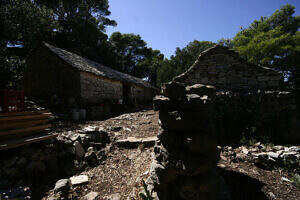
Na rubu teme: Prodaja napuštenih sela
U proljeće 2008. Dragodid se povlačio po većini dnevnih listova, tragom (dez)informacije o njegovoj prodaji za 370.000 EUR. Ton članaka, a posebno komentara čitalaca u internet izdanjima novina, bila je žalopojka.
Usporedite ovo: otprilike u isto vrijeme u Španjolskoj je objavljena prodaja napuštenog sela po cijeni od senzacionalno povoljnih 48.080 EUR, što je podiglo pravu lavinu, ali ne žalopojki, nego alternativnih prijedloga za održivo korištenje (tog i sličnih sela), i naravno, ponuda za kupnju. Epilog priče nam nije poznat.
(link na članak poslao J. Kale)
Needs some updating: Buyers flock to bid for abandoned Spanish hamlet By Elizabeth Nash in Madrid The Independent, 13 February 2008
A modest advertisement offering an abandoned village for sale in a remote corner of Spain has prompted a buyers’ frenzy, not just from those seeking a bargain in a flagging market, but among idealists proposing detailed plans for rural regeneration.
The hamlet of Conejares recently came on the market for €48,080 (L35,700), and produced so many inquiries – including firm offers – that its owner has gone to ground, turned off his mobile, and withdrawn the advertisement.
The sale was posted on a website devoted to abandoned villages, of which there are 2,700 throughout Spain. After the deluge of potential buyers, Conejares was removed from the site, apparently to clarify details of the ancient title deeds.
The last farm labourers left the hamlet, 185 miles north-east of Madrid, 70 years ago. Today’s owner of what is little more than a heap of rubble and stone walls in picturesque surroundings does not exactly oversell his
product: “Conejares does not appear on the map, and has no water or electricity, although a high-tension cable passes a kilometre away.”
It adds, encouragingly: “It should not be difficult to get permission to dig a well,” and points out that plentiful water is apparently available not too far below ground.
The village is surrounded by cornfields, with only a dirt track linking it to a road between the two nearest towns of Muro de Agreda and Matalebreras in the province of Soria, whose bleak uplands border the harsh region of Aragon.
This is the most depopulated region of Spain.
“Even those from around here had never heard of it,” said Eva Sanchez, a journalist on the regional paper Diario de Soria who photographed the ruins.
The successful buyer would get three houses, a church – in reality, the remains of a tiny hermitage – and a livestock enclosure, all in a plot of 6,000 square metres, classified by the municipal registry as rustico. This detail is important, because if a future developer wanted to transform this rural hideaway into a casino, say, or even a holiday development, it could involve complex applications for permission to reclassify the land for building, or commercial activity.
For years, Conejares was physically and administratively invisible. None the less, the for-sale notice created an online sensation, prompting a blizzard of chat forums, digital commentaries and alternative blogs. An “auction”
attracted one proposal to gather a group of 50 people to buy the village jointly with the aim of repopulating it. Others suggested the installation of low-cost industries to create a nucleus of activity that could reverse the plague that blights rural Spain: the flight to the cities. A further proposal was to set up an agrarian co-operative that would sell local produce directly without the need for intermediaries.
Online discussions also produced the proposal of a common fund to be managed by the council of Olvega that would be distributed among future villagers by means of a tailor-made credit card.
Bloggers discussed how this might be organised, how much each member would contribute, and even daily life in a reborn Conejares. The idea of reviving the hamlet as a commercially viable operation is not as utopian as it sounds.
Nearby Valdelavilla was rescued from oblivion years ago by a language school, Pueblo Ingles (English Village), which turned the village’s isolation into an advantage: it banned the speaking of Spanish, and developed the remote spot as a centre for learning English by total immersion.
The mayor of Olvega, Gerardo Martinez, is bemused by the brouhaha. “It’s not even a proper village,” he said yesterday. “It’s just a hillock where there used to be some cattle sheds, and now there’s nothing.”
